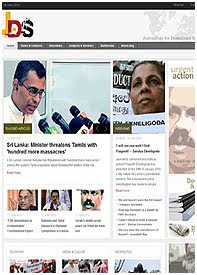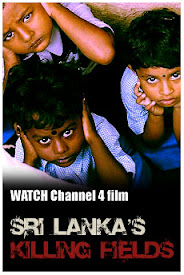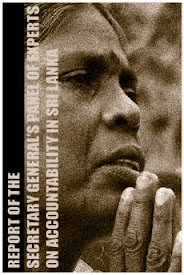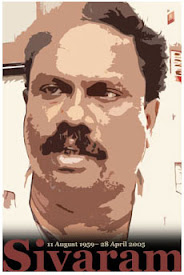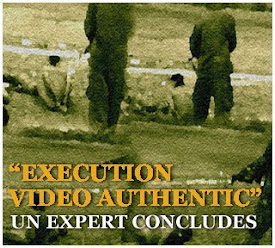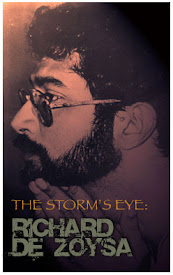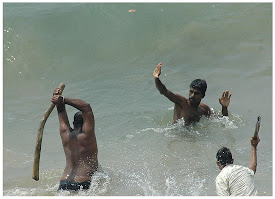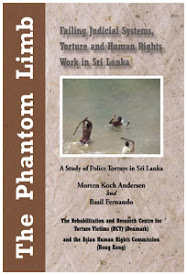The Sri Lankan government has stepped up its campaign to discredit footage claiming to show Tamils being executed by Sri Lankan soldiers, which was broadcast by Channel 4 News last month.
The footage, obtained by Journalists for Democracy in Sri Lanka (JDS), apparently shows government troops summarily executing Tamil fighters by shooting them in the head. JDS says the footage was filmed in January by another soldier using a mobile phone. Jonathan Miller's report contains extremely disturbing images.
In an interview on the BBC's Today programme on 11 September, Prof Rajiva Wijesinha, the top civil servant in the Sri Lankan ministry of disaster management and human rights, said the apparent execution video was "lies". He accused Channel 4 News of broadcasting the material without bothering to check it.
JDS insists the video clip was taken during the war when independent local media was prevented from covering the conflict. "This videoclip shows the reality of the behaviour of the government forces during the war which the government called a 'humanitarian operation' to rescue the Tamils," they say.
The Sri Lankan government launched a large-scale military offensive in January of this year, capturing the Tamil Tiger held town of Kilinochchi. The army then steadily pushed the rebels into a small area of the north east, but the international media were prevented by the Sri Lankan government from covering the conflict zone.
The pictures in the accompanying report, broadcast on 25 August 2009, apparently show government troops executing Tamils. A naked man is seen blindfolded and bound, being kicked in the head by a soldier before being shot.
As further gunshots are heard, the camera turns to show eight other bound bodies, all but one of which are naked. There is no indication of the ethnicity of the dead men, but the group which obtained the pictures claim the victims are Tamils. The killers are speaking Sinhala and they appear to be wearing Sri Lankan army uniforms.
It is not possible for Channel 4 News to authenticate independently the pictures. JDS is not a Tamil liberation group, but an organisation made up of exiled Sri Lankan journalists, including Sinhalese and Tamils.
On Monday 7 September, the Sri Lankan government held a press conference to refute the footage. A spokesmen said they had analysed the footage and determined it had been faked in a way that was typical of the Liberation Tigers of Tamil Eelam (LTTE).
Sri Lanka’s human rights minister, Mahinda Samarasinghe, said four investigations by military and civilian experts from Sri Lanka showed the footage was staged and had had its sound manipulated.
However, in the course of previous week UN Secretary-General Ban Ki-Moon discussed the video with Samarasinghe, the US ambassador to the UN Susan Rice expressed "grave concern" about the "disturbing" images, and UN special rapporteur on extrajudicial, summary or arbitrary executions, Philip Alston, called for a probe.
Andy Duncan, Channel 4's chief executive, stands by the decision to broadcast the report, saying it "made clear throughout the report that we could not verify its authenticity or veracity".
"In that context, we believed it was important that this footage was placed into the public domain," he said.
Channel 4 News today learned that a US Senate committee has asked the state department's war crimes unit to investigate crimes against humanity and identify the perpetrators.
We understand the Americans are examining photographic evidence of the killing of civilians in Sri Lanka. And their investigation could affect American military aid to the island.
© Channel 4
Saturday, September 12, 2009
Sri Lanka steps up death video rebuttal
Saturday, September 12, 2009
"we won't have independent inquiries into any Tom, Dick and Harry allegation" - Prof. Rajiva Wijesingha
By Krishnan Guru-Murthy - The spokesman for Sri Lanka's ministry of disaster management responds to claims that his country was involved in human rights abuses and extra-judicial killings.
A transcript of Krishnan Guru-Murthy’s interview with Professor Rajiva Wijesinha of the Sri Lankan ministry of disaster management.
KGM: You’ve been urged by the international community to investigate human rights abuses and extra-judicial killings. Have you started yet?
RW: Yes. Sri Lanka has had commissions of inquiry when evidence is presented before us. I think the problem with this particular video is, it’s a gross generalisation.
When Philip Alston wrote to us, I wrote back to him immediately. We were slightly worried about the fact that Mr Alston, contrary to his promise to us previously, actually sent us a letter at 2.45 in the afternoon and followed this up with a public press release that contradicted what he…
KGM: But he wants an independent inquiry…
RW: I’m sorry. Can I finish? What he said in the letter to us is, could we have an investigation by Sri Lanka?
Now, when you send a letter at 2.45 and follow it up 45 minutes later on a Friday afternoon with a claim for an independent inquiry, that makes a mockery of the letter you’ve sent us.
Now, we have the feeling that Professor Alston – he’s done this before, he’s quite a nice man but gets carried away by idealism… You know, the last time we thought he’d attack us he spent a long time against Nato.
I think there’s a certain political element in this. I’ve actually wondered why he hasn’t pointed out there was some extra-judicial killings in Sri Lanka which were very bad, but these have not been asked inquiry into.
KGM: But have you actually held the independent inquiry? Has it begun? And in what form is it independent?
RW: I’m sorry, but we don’t have to have so-called independent inquiries into any Tom, Dick and Harry allegation. We pointed out to him that we had an extra-judicial killing a couple of weeks ago. We are sorry he wasn’t concerned about that. But that’s because it was not grist to the mill of LTTE…
KGM: This isn’t a Tom, Dick or Harry allegation. This is an allegation that the United States ambassador to the UN says gives her grave concern.
RW: What we wrote to Philip Alston was to say…
KGM: Let me finish the question.
RW: I’m sorry. I’m answering your question. Your question was about the video. We wrote to Philip Alston to say, very gently: “Do you have any evidence of such an incident taking place? Or are you telling us that a video was shown by Channel 4? In that case, could you tell us perhaps where this incident took place or when it took place? Or ask Channel 4, if they wish to conceal whoever told them, to at least give some information so we can proceed.”
KGM: So you’re not going to go looking for evidence of extra-judicial killings until somebody comes to you and says: “This is when we believe the incident happened. This is who we believe was involved”? You’re not going to go and interview armed forces personnel to find out?
RW: How can we go into generalisations? We’ve gone into this video itself which, as you say, you haven’t actually given to us, but we’ve gone into what we could see of it.
We have found certain discrepancies. There were some technical ones which I believe your correspondent, if he was there at the press conference…
KGM: We’ve just listed those.
RW: Yeah. But no, you haven’t mentioned the technical difficulties. What you’ve mentioned is certain discrepancies. You didn’t show that wonderfully moving leg. You didn’t show the way in which the man who was shot in the back of the head went down very smoothly, like that.
So these are areas in which we would now like you to at least tell us who these Journalists for Democracy are.
When I spoke to you a bit earlier, I’m glad that I gave you all the points I was going to make – which was a bit more than you did to our high commissioner, because when you invited him to speak, they asked to see the video before and you refused to show it to him.
KGM: Well, that does bring us to another question, really… Let me get another question in for a second, because you say when we approached your high commission on the day of this, just before broadcast, they gave us an extensive denial. And that has been your position throughout. They gave us that denial without having actually seen the video themselves…
RW: They asked to see it and you refused.
KGM: And you stuck to that position all the way through.
RW: I’m sorry. They asked to see it. You refused to show it to them. You said your policy was not to show these things… I’m sorry, this is what you said.
But you’ve showed it to a so-called independent human rights expert – you haven’t told us who he is – who said it was authentic.
At some point you’ve got to realise that you’ve got to be at least consistent.
KGM: Fine. OK. The point is, you’ve got to convince the United States and the United Nations and governments like Norway, who described this as more than solid evidence to accuse the Sri Lankan government.
Now, have any of them, since you came out with your rebuttal this week, come to you and said: “OK. We’re convinced. We drop our concerns”?
RW: Well, we’ve written to Alston and he hasn’t replied to my last letter. The Norway… Mr Solheim is not the Norwegian government. We have had discussions with the Norwegian ambassador in Sri Lanka.
KGM: None of them have accepted your version of events, have they?
RW: Well, they have not actually mentioned a version of events. Solheim said very clearly the video does not seem to be authentic. He didn’t say it was obviously false.
But he, like you, hides behind this wonderful suggestion: “We’re not responsible for this. We don’t know if it’s authentic – but have a look.”
And I think that sort of approach, that I think you’ve been taking up, is really an attempt to put doubt in people’s minds, whereas your responsibility was (a) to check that video carefully, as our experts have done.
We’ve now shown you what we think is wrong. Prove that we weren’t wrong. Show us that that leg did not move. You can change the video again.
And also, most importantly, you talk about the Journalists for Democracy and say because they’re Sinhalese, it must be authentic.
Let me tell you that this is not a matter of race. People can be wicked, whatever race they are. Most of the Tamils in Sri Lanka are relieved the LTTE is over.
But this particular group have had a lot of ties with the opposition in Sri Lanka. We know that. I told your people this morning. Investigate, please.
KGM: OK. You’ve had a chance to make that clear. Professor Wijesinha, thank you very much indeed for joining us today.
© Channel 4
Saturday, September 12, 2009
Campaigners defend Lanka video - JDS Responds to the minister
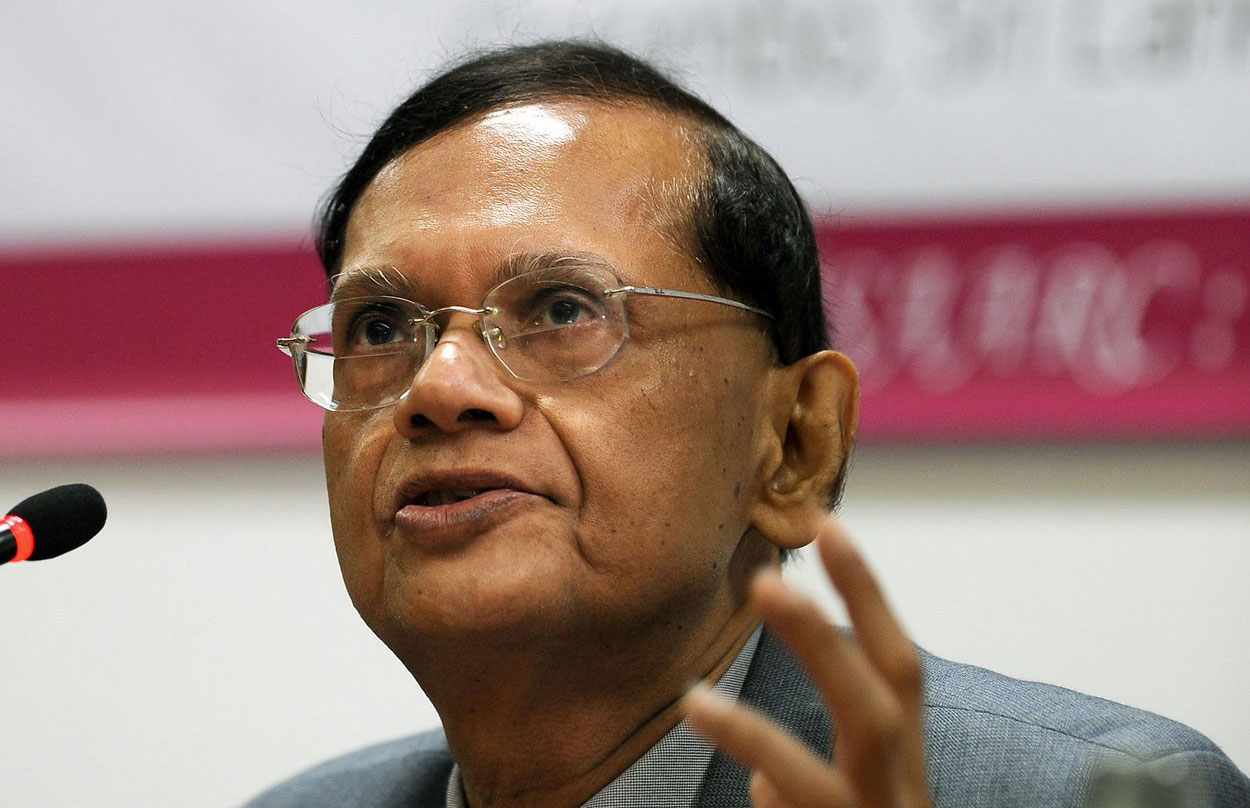
By Tony Cross - Was a video showing Sri Lankan soldiers a fake? A government minister says yes and one reader agrees but the group that distributed the clip answers its critics.
Sri Lanka’s International Trade Minister GL Peiris this week told RFI that a controversial video of soldiers apparently shooting prisoners is a fake and rejected calls for an international inquiry into the alleged incident. Journalists for Democracy in Sri Lanka (JDS) which made the clip public has replied to the minister.
“Since the government of Sri Lanka has started a vicious campaign against JDS, we are compelled to find ways to counter their reactions without exposing any of our sources on the ground,” a representative, who prefers to remain anonymous for fear of reprisals, writes.
In reply to Peiris’s argument that an international inquiry would be a breach of Sri Lanka’s sovereignty, he says:
“The war in Sri Lanka has a history. Sri Lankan state would not have been able fight such a massive war without the external support they had. It was funded by external powers. The weapons, training, expertise came from outside. Foreign militaries got involved. But no one said that the whole issue is being excessively internationalized, and that will affect the sovereignty of Sri Lanka as long as everyone backed the military option. But now, when some international bodies started to raise human rights concerns, the government of Sri Lanka seems to be very much interested in raising the sovereignty argument.”
JDs argues that sovereignty “does not mean a state should be given an unconditional right to killl its own citizens” and cites accusations made against several countries, including Guatemala, El Salvador, Cambodia, Chili, South Africa and Rwanda.
“When the present leaders of the Sri Lankan government - specially President [Mahinda] Rajapaksa - kept on attending the UN human rights council meetings in the late '80s as an opposition parliamentarian to appeal to the world to intervene and stop the state sponsored killings in the South of Sri Lanka, where were all these "sovereign state" arguments?” JDS asks. “Regardless the fact that there had been requests made by many international bodies, Sri Lanka has never carried out a single independent inquiry to investigate the crimes that were committed under the banner of ‘sovereignty’. Just one example: Since April 2004, at least 34 media workers have been killed. We, the JDS, has listed all the names with relevant details. Mr.Peries should reveal how many perpetrators have been brought to justice? So here the logic seems to be ‘No justice = Full sovereignty’.
Peiris said that an analysis had shown that the video is fake.
JDS replies:
"Mr.Peries is talking about a piece of video evidence, where anyone can clearly see some unarmed men were been killed in cold blood by some armed men who appeared to be wearing the uniforms which are very much identical to that of the Sri Lankan army. That is a crime that should be investigated not by "somebody in Sri Lankan media", but by an transparent institutional body that is independent and internationally recognized. When you are being accused of committing a crime and seen as the perpetrator, you cannot be the judge as well. If it is to be independent and accepted, the Sri Lankan government and its military should stay out of the way completely and let an independent invesitigating body to do the job, without any interference. Unless it is done, what is fake is not the video clip, but the so called ‘technical analysis’ done by ‘somebody’, whose name doesn't seem to be remembered even by the minister himself.”
Another correspondent, Bully Sammy, takes the minister’s side and sends a link to an analysis of the video.
© Radio France International
Related Links:
No to shootings video inquiry, says Lanka minister - Radio France International
Saturday, September 12, 2009
The Sri Lankan media war continues
In May the Sri Lankan Army defeated the seperatist Tamil Tigers in a military push that left 20,000 civilians in the last month of fighting alone.
The Listening Post has previously reported on how the Sri Lankan government prevented most of the media from entering the the war zone.
UN human rights groups and journalists are working to uncover the truth about the last bloody days of the battle.
A disturbing video has surfaced that appears to show cold-blooded executions. The video has provoked an immediate response from the Sri Lankan government and a fight over the veracity of the footage is being waged all the way from the capital, Colombo, to London.
© Al Jazeera
Saturday, September 12, 2009
UN warns Sri Lanka over prison camps

By Andrew Buncombe - In its firmest warning yet to the government of Sri Lanka, the United Nations has said it cannot indefinitely continue funding the huge refugee camps in the north of the country. The world body urged the authorities to allow the hundreds of thousands of Tamil civilians to leave. In comments that appear to underline a hardening of attitude towards Sri Lanka, the senior UN official in the country said the camps should be a last resort for civilians with nowhere else to go. Sri Lanka faces increasing international criticism over its treatment of the estimated 300,000 civilians held in camps, with the EU poised to cancel a trade concession worth $1bn to the government.
Four months after the government defeated Tamil rebels and ended a decades-long civil war, aid groups have complained that conditions in the vast Menik Farms camp, where most people remain behind razor-wire, are still inadequate.
"Nothing has changed over the past three months for the people in the camps," the UK-based Catholic Fund for Overseas Development said yesterday. "They are overcrowded, with poor sanitary conditions and inadequate health care. There are concerns about what may happen when the monsoon rains arrive in the next couple of months."
The UN's senior official in Sri Lanka, Neil Buhne, told the BBC: "The best solution is, obviously, that as many people leave as soon as possible; and, for the people who have no place else to go, that the site can become an open one." The UN secretary general, Ban Ki-moon, has also said he intends to speak directly to the Sri Lankan President, Mahinda Rajapaksa, to protest against the decision to expel the spokesman for Unicef, accused by the government of acting as "propagandist" for the Liberation Tigers of Tamil Eelam. He will also raise the issue of two UN workers in the Tamil-dominated north arrested in June.
One source in Colombo said: "I don't think [Mr Buhne] was throwing down the gauntlet at the government, but I think he was placing it down. There is a definite disappointment at the pace things are being done, and that promises have not been fulfilled."
After the war, Mr Rajapaksa said most civilians would be allowed home by the end of this year, but only a small number of elderly people, children and priests have left. Yesterday, a government spokesman said that about 10,000 civilians had gone home by bus.
© The Independent
Saturday, September 12, 2009
Sri Lankan government evicted UN diplomat during Tamil Tiger endgame

Randeep Ramesh - A senior UN diplomat was expelled from Sri Lanka for providing detailed rebuttals of government "wartime propaganda" during the final battles against Tamil Tiger rebels, the Guardian has learned.
In July Peter Mackay, an Australian citizen, was given two weeks to leave the country, despite having a visa that ran until the summer of next year.
The diplomat, who was monitoring the conflict, had put together briefings for embassies in Colombo that challenged Sri Lanka's official civilian death toll and its arrangements for relief operations.
News of his expulsion comes days after the UN chief, Ban Ki-Moon, denounced Sri Lanka's decision to expel Unicef's communications officer, James Elder, from Colombo for "supporting terrorism".
Elder had spoken out on child casualties and malnutrition rates during the fighting and criticised the inadequate provisions for war refugees once the battles were over.
Mackay, a field operative who worked for UNOPS – the technical arm of the UN – was a less familiar face to the media. But he played a key role in keeping the outside world informed about the number of civilians killed in the final months of the war – deaths that Sri Lanka was keen to play down.
Mackay collected high-resolution satellite images showing that the number of people trapped on beaches where the Tigers made their last stand was far higher than that claimed by the government.
The data showed that not only were more people in danger than the government admitted, but that the food and medicine sent to the "no fire zone" were inadequate.
Mackay was also in touch with local staff and put together briefings, using eyewitness reports of the war, which led the UN to warn of a "bloodbath" in the final weeks of fighting.
The diplomat is seen as a legal timebomb by the Sri Lankan government as he could personally take the stand and testify that the army shelled non-combatants – action considered to bea war crime under international law.
Mackay's experience and knowledge of rebel territory made him the ideal UN candidate to record how the war was being fought. He was stranded behind Tamil Tiger lines on a mission to rescue 100 local staff and their families and was repeatedly bombed for 10 days in January, despite desperate calls to army commanders by his superiors imploring them to stop firing.
His presence, however, attracted the attention of Sri Lanka's military. In a letter sent in late July, the authorities gave him two weeks to pack up, saying that his "adverse activities had come to the notice of the intelligence services".
A senior UN source confirmed that Mackay had been asked to leave, adding that "the issue was taken up through diplomatic channels with the government, but their decision remained unchanged".
The expulsion of two UN officials in the matter of a few weeks sets an unprecedented record for the Sri Lankan government, which is still smarting from criticism of its "take no prisoners" approach to defeating the Tamil Tigers in May – ending 26 years of civil war.
© The Guardian
Saturday, September 12, 2009
Counting the human cost of Sri Lanka's conflict
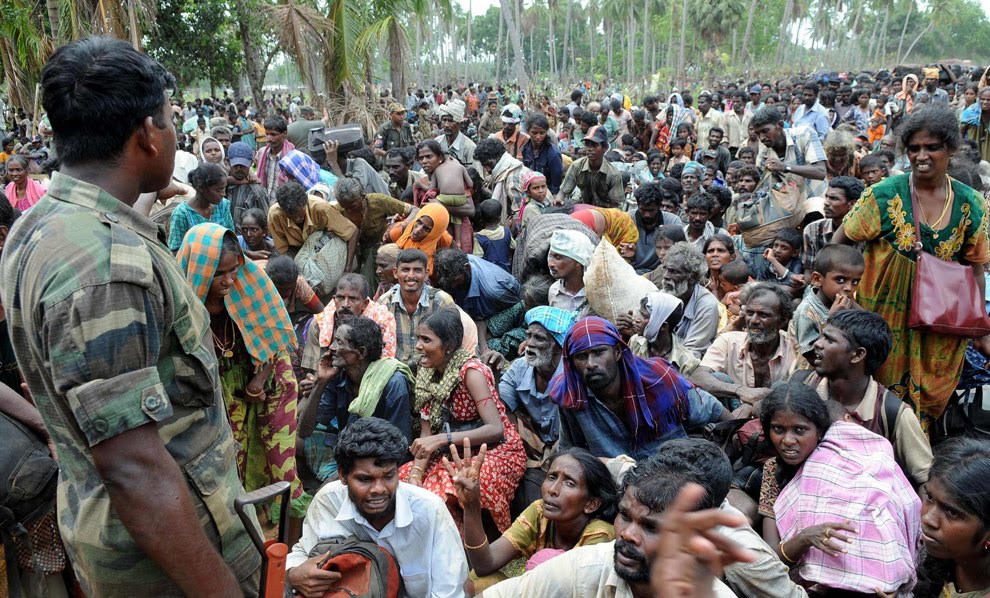
The Government of Sri Lanka announced a plan on 23 May to resettle most civilians displaced by conflict by the end of the year. The government’s target of 80% was later revised downward to 60%.
The 180-day process was to include both people newly displaced by fighting in the north, as well as people who had been displaced for extended periods of time.
Some Sri Lankan families have been displaced for years or decades and the process of resettling them has been ongoing. Minister of Resettlement and Disaster Relief Services Rishad Bathiudeen told Sri Lanka’s Parliament in August that the Government had re-settled more 59,000 war-displaced families in recent months, mainly victims of earlier displacements in the east.
According to UN relief statistics, as of 28 August, 266,567 people displaced by conflict in the north after 1 April 2009 remained in camps and hospitals. This is down from about 280,000 in June. Almost 250,000 of them were in Vavuniya district.
The Government’s plan to return people to their places of origin has four phases, with families from eastern Sri Lanka and Jaffna returned first, followed by Vavuniya, Mannar and finally from the former LTTE strongholds of Kilinochchi and Mullaitivu. The Office of the President is responsible for coordinating this plan.
By the end of August, 6,490 people were reported to have been released from camps to stay with host families or in elders’ homes by the end of August. The majority of these people were elderly or disabled. 5,123 people were returned to Jaffna, Vavuniya, Mannar, Trincomalee, Batticaloa and Ampara districts between 5 August and 28 August.
On 26 August, some 800 Hindu and Catholic priests were released from camps for displaced people in Vavuniya. On 20 August, 130 people displaced in 2006 were moved from sites in Batticaloa District to Trincomalee District, but they were unable to return home because their land is within a military-designated High Security Zone. They have been accommodated in a school and another public building.
© Amnesty International
Saturday, September 12, 2009
Fears for safety of UN official

Matt Wade - An Australian, United Nations official has received anonymous threats to his safety days after being branded a terrorist sympathiser by the Sri Lankan Government and ordered to leave the country.
James Elder, the United Nations Children's Fund spokesman in Sri Lanka and the father of three young children living in Colombo, must leave Sri Lanka in less than a fortnight after having his visa revoked.
This week Sri Lanka's former foreign secretary, Palitha Kohona - also an Australian citizen - accused Mr Elder of ''doing propaganda'' in support of the Tamil Tigers insurgency.
Dr Kohona's comments have raised fears about the safety of Mr Elder and his family in a country where ethnic tensions remain high just months after the end of a long-running civil war.
Dr Kohona, who worked for Australia's Department of Foreign Affairs and Trade for more than a decade before returning to Sri Lanka, has just become Sri Lanka's representative to the United Nations, the organisation that employs Mr Elder.
The Age believes Mr Elder has received intimidating phone messages after it was announced that his visa would be cancelled on September 21. It is not suggested that Dr Kohona is behind the threats to Mr Elder's safety.
Even if the Sri Lankan Government reverses its decision to expel Mr Elder, Dr Kohona's comments appear to make his position in Sri Lanka untenable.
The Tamil Tigers are a proscribed terrorist organisation in many countries, including Australia.
After more than 25 years of fighting, separatist Tamil Tiger rebels were routed by the Sri Lankan army in May and the group's leader, Vellupillai Prabhakaran, killed.
Mr Elder, who has been UNICEF's spokesman in Sri Lanka for more than a year, made frequent statements to the media about the plight of children caught up in the conflict and who were subsequently sent to guarded camps for Tamil refugees. Sri Lanka has stridently resisted international pressure to allow an investigation into allegations of a high civilian death toll and war crimes during the closing stages of the war.
It is estimated that between 7000 and 20,000 civilians were killed in the final weeks of the war and many of the victims were children.
The Australian Government has offered Mr Elder consular assistance, but so far the Government's reaction to the expulsion has been muted.
Mr Elder has received strong support from the highest level of the UN.
Secretary-General Ban Ki-moon said he ''strongly regrets'' the decision and would take up Mr Elder's case with Sri Lanka's President, Mahinda Rajapaksa.
''The United Nations is working impartially to assist the people of Sri Lanka, and the Government should be supporting and co-operating with its efforts,'' he said.
There was great tension between Sri Lanka and the UN in the bloody climax to the civil war in the first five months of this year.
Jehan Perera, head of Colombo's National Peace Council, said Mr Elder's expulsion showed the Sri Lankan Government had not yet moved on from its wartime mindset.
© The Age
This site is best viewed with firefox

Search
Is this evidence of 'war crimes' in Sri Lanka?
Archive
-
▼
2009
(496)
-
▼
September
(134)
-
▼
Sep 12
(8)
- Fears for safety of UN official
- Counting the human cost of Sri Lanka's conflict
- Sri Lankan government evicted UN diplomat during T...
- UN warns Sri Lanka over prison camps
- The Sri Lankan media war continues
- Campaigners defend Lanka video - JDS Responds to t...
- "we won't have independent inquiries into any Tom,...
- Sri Lanka steps up death video rebuttal
-
▼
Sep 12
(8)
-
▼
September
(134)
- ► 2010 (1312)
- ► 2011 (687)
Links
- Reporters Sans Frontières
- Media Legal Defence Initiative
- International Press Institute
- International News Safety Institute
- International Media Support
- International Freedom of Expression eXchange
- International Federation of Journalists
- Committee to Protect Journalists
- Asian Human Rights Commission
- Amnesty International
